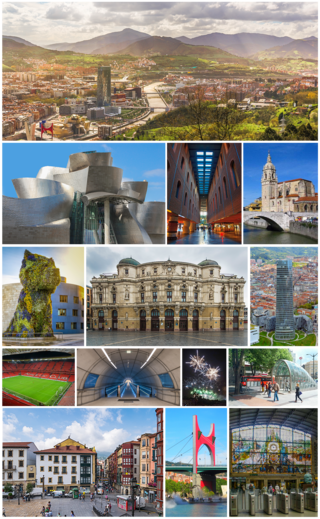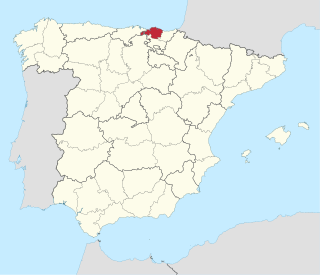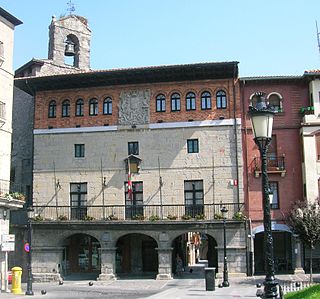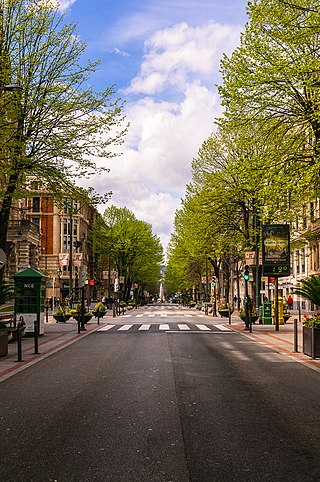
Bilbao is a city in northern Spain, the largest city in the province of Biscay and in the Basque Country as a whole. It is also the largest city proper in northern Spain. Bilbao is the tenth largest city in Spain, with a population of more than 347,000 as of 2023. The Bilbao metropolitan area has 1,037,847 inhabitants, making it the most populous metropolitan area in northern Spain; with a population of 875,552, the comarca of Greater Bilbao is the fifth-largest urban area in Spain. Bilbao is also the main urban area in what is defined as the Greater Basque region.

Biscay is a province of Spain and a historical territory of the Basque Country, heir of the ancient Lordship of Biscay, lying on the south shore of the eponymous bay. The capital and largest city is Bilbao.

The River Nervión runs through the town of Bilbao, Spain into the Cantabrian Sea. Its lowermost course, downstream of its confluence with the Ibaizabal River, is known as the Estuary of Bilbao.

Cosme Damián de Churruca y Elorza was a Basque Spanish noble, admiral of the Royal Spanish Armada, naval scientist and Mayor of Motrico. During the Battle of Trafalgar, he was the commander of the ship of the line San Juan Nepomuceno which he defended to his death.

Portugalete is a town lying to the west of Bilbao in the province of Biscay in the Autonomous Community of Basque Country, northern Spain.

Mutriku is a coastal town located in the province of Gipuzkoa in the Autonomous Community of Basque Country in northern Spain. It has a population of around 5000 and provides access to the Bay of Biscay. It is the site of the world's first multi-turbine breakwater wave power station, opened July 8, 2011. The Church of San Andrés can be found here, being one of the oldest churches in Gipuzkoa, dating to the year 1080.

Santurtzi is a port town in the province of Biscay, in the autonomous community of Basque Country, Spain. It is located in the Bilbao Abra bay, near the mouth of the Nervión river, on its left bank, 14 km downriver from Bilbao and forms part of the Greater Bilbao agglomeration. It has a population of 45,853 (2019) and a land area of 6.77 km².

Urduña/Orduña is an exclave and municipality of 4,232 inhabitants located in the province of Biscay, in the autonomous community of Basque Country, in the North of Spain.

The Vizcaya Bridge is a transporter bridge that links the towns of Portugalete and Las Arenas in the Biscay province of Spain, crossing the mouth of the Nervion River.
The Estuary of Bilbao lies at the common mouth of the rivers Nervion, Ibaizabal and Cadagua, which drain most of Biscay and part of Alava in the Basque Country, Spain. In this instance, the Spanish word estuario is used to describe what in English would normally be called part estuary, part tidal river. The estuary becomes a tidal river which extends 16 km (9.9 mi) into the city of Bilbao, starting from the Bilbao Abra bay. It hosts the port of Bilbao throughout its length, although the Port Authority has recently restored most of the upper reaches to Bilbao and other municipalities for their urban regeneration. The port is now being transferred to the seaboard on the coast at Santurtzi and Zierbena.

The Ibaizabal is a river that drains southeastern Biscay to the Estuary of Bilbao. It is 43 kilometres (27 mi) long from its source at Elorrio to the Nervión, and it passes by the towns of Durango and Amorebieta and joins the Nervión river at Basauri. Both rivers run then together for a short length until they merge with the sea at Bilbao. It is disputed which river is the one that actually reaches Bilbao. It is commonly agreed that it is the Nervión, but there are some who argue that the Ibaizabal carries more water.

Areeta is a neighbourhood of Getxo. It is an affluent residential area that was built over the sands of a beach where the Gobela Creek died into a diffuse delta at the mouth of the Estuary of Bilbao in the early 20th century.

Abando, formerly known as San Vicente de Abando, is one of the eight districts of Bilbao, Basque Country (Spain). It covers most of the city's centre, located on the left bank of the estuary of Bilbao. It is the only district of Bilbao with all of its land completely urbanised. Abando was originally an elizate and also a municipality until 1876, when part of it was annexed to Bilbao, the rest of the elizate's municipal land was integrated into Bilbao in 1890. In 2016 the population was 50,903. Abando is the wealthiest district in Bilbao, with personal and family incomes being well above the citywide average.

The Port of Bilbao is located on the Bilbao Abra bay, and along the Estuary of Bilbao, in Biscay. The main facilities are in the Santurtzi and Zierbena municipalities, approximately 15 km (9.3 mi) west of Bilbao. Also called Exterior Port and Superpuerto, the port complex occupies 3.13 km² of land and 16.94 km² of water along 17 km (10.6 mi) of waterfront.

Raza is a 1942 Spanish war film directed by José Luis Sáenz de Heredia, and used as propaganda by the dictatorship of Francisco Franco in favour of the regime and against the supporters of the deposed Second Spanish Republic. It is based on a semi-autobiographical novel by Spanish caudillo Francisco Franco under the pseudonym of "Jaime de Andrade."
Evaristo is both a given name and a surname. Notable people with the name include:

José Luis Díez was a Churruca-class destroyer in the Spanish Republican Navy. She took part in the Spanish Civil War on the government side.
José María Núñez Urrezola is a Spanish former professional football manager and former player who played as a left back.
Eugenio Fojo y Márquez was a Spanish rose breeder who founded "La Florida" in northern Spain and the Basque Country. It was the most influential plant nursery and garden design firm in the 1930s. His rose, 'Irene Churruca,' is still sold as one of the classic roses of that era.
The Club Atleta de los Astilleros del Nervión was an multi-sports club based in Nervión, Biscay, that mainly consisted of the British workers of the Nervión Shipyards, hence its name, but sometimes also with players hailing from all across Bilbao. It was one of the very first companies dedicated to sports in the region, most notably, football, having a section dedicated to the said sport due to its rapid growth in England. In addition to football, Club Atleta also performed in other modalities such as athletics, cricket, and cycling, although they also practiced others such as rugby, rowing and tug of war.















